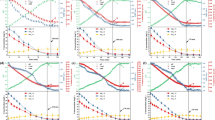Abstract
This paper presents a real-time control strategy based on the derivative of the oxi-reduction potential (ORP) values for nitrogen removal via nitrite in a sequencing batch reactor (SBR) fed with effluent from an anaerobic sequencing batch reactor (ASBR) treating dairy wastewater. The developed control strategy optimized the length of aerobic and anoxic phases without external carbon source addition. Firstly, a fixed interval length for aeration period was used in the SBR cycle to promote the nitrogen removal; however, this strategy did not allow the proper alternation of anoxic and aerobic conditions, and thus effective removal of nitrogen was not verified. After that, the real-time control strategy was implemented, and the end of nitrification and denitrification processes was determined when the derivative of the oxi-reduction potential (ORP) was close to zero. This strategy provided a removal of 92.2 ± 9.7 and 63.9 ± 19.0% for concentrations of TKN-N and Nt-N, respectively, which were well above those found for the open-loop system—43.8 ± 21.6 and 26.5 ± 26.2% for the removal of TKN-N and Nt-N, respectively.



Similar content being viewed by others
References
Alleman, J. E. (1980). Elevated nitrite occurrence in biological wastewater treatment systems. Water Science Technology, Oxford, 17, 409–419.
Antileo, C., Medina, H., Bornhardt, C., Muñoz, C., Jaramillo, F., & Proal, J. (2013). Actuators monitoring system for real-time control of nitrification–denitrification via nitrite on long-term operation. Chemical Engineering Journal, 223, 467–478.
APHA/AWWA/WEF. Standard Methods for the Examination of Water and Wastewater, 22th ed. American Public Health Association, Washington, DC, 2012.
Chen, K. C., Chen, C. Y., Peng, J. W., & Houng, J. Y. (2002). Real-time control of an immobilized-cell reactor for wastewater treatment using ORP. Water Research, 36, 230–238.
Claros, J., Serralta, J., Seco, A., Ferrer, J., & Aguado, D. (2012). Real-time control strategy for nitrogen removal via nitrite in a SHARON reactor using pH and ORP sensors. Process Biochemistry, 47, 1510–1515.
Daniel, L.M.D. (2005) Nitrogen removal through nitrite in sequential batch reactor with immobilized biomass and intermittent aeration. PhD Thesis, University of São Paulo, São Carlos, 2005.
Dillalo, R. E., & Albertson, O. E. (1961). Volatile acids by direct titration. Journal WPCF, 33, 356–365.
Hao, J. O., & Kim, H. (2000). pH and oxidation reduction potential (ORP) strategy for optimization of nutrient removal in an alternating aerobic-anoxic system. Water Environ. Res., 73(1), 95–102.
Holman, J. B., & Wareham, D. G. (2005). COD, ammonia and dissolved oxygen time profiles in the simultaneous nitrification/denitrification process. Biochemical Engineering Journal, 22, 125–133.
Jenkins, D., Richard, M.G., Dagger, G.T. (2003). Manual on the causes and control of activated sludge bulking, foaming, and other solids separation problems. 3rd. ed. Boca Raton: Lewis Publishers.
Kishida, N., Kim, J. H., Chen, M., Sasaki, H., & Sudo, R. (2003). Effectiveness of oxidation-reduction potential and pH as monitoring and control parameters for nitrogen removal in swine wastewater treatment by sequencing batch reactors. Journal of Bioscience and Bioengineering, 96, 285–290.
Lackner, S., & Horn, H. (2013). Comparing the performance and operation stability of an SBR and MBBR for single-stage nitritation-anammox treating wastewater with high organic load. Environmental Technology, 34(9–12), 1319–1328.
López-Palau, S., Pinto, A., Basset, N., Dosta, J., & Mata-Álvarez, J. (2012). ORP slope and feast–famine strategy as the basis of the control of a granular sequencing batch reactor treating winery wastewater. Biochem. Eng. J, 68, 190–198. doi.:10.1016/j.bej.2012.08.002
Ndegwa, P. M., Wang, L., Vaddella, V. K. (2007). Potential strategies for process control and monitoring of stabilization of dairy wastewater in batch aerobic treatment systems. Process Biochemistry, 42 (9), 1272–1278. doi:10.1016/j.procbio.2007.06.001
Pochana, K., & Keller, J. (1999). Study of factors affecting simultaneous nitrification and denitrification (SND). Water Science and Technology, 39(6), 61–68.
Pavselj, N. H., Kocijan, N. J., Ro, M., Ubelj, M., Mul, G., & Stmnik, S. (2001). Experimental design of an optimal phase duration control strategy used in batch biological wastewater treatment. ISA Transactions, 40, 41–56.
Ripley, L. E., Boyle, W. C., & Converse, J. C. (1986). Improved alkalimetric monitoring for anaerobic digestion of high-strength wastes. Journal WPCF, 58, 406–411.
Tanwar, P., Nandy, T., Ukey, P., & Manekar, P. (2008). Correlating on-line monitoring parameters, pH, DO and ORP with nutrient removal in an intermittent cyclic process bioreactor system Bioresour. Technology, 99, 7630–7635.
Wareham, D. G., Hall, K. J., & Mavinic, D. S. (1993). Real-time control of wastewater treatment systems using ORP. Water science and technology., 28(11–12), 273–282.
Won, S. G., Ra, C. S. (2011). Biological nitrogen removal with a real-time control strategy using moving slope changes of pH (mV)- and ORP-time profiles. Water Research, 45(1), 171–178. doi:10.1016/j.watres.2010.08.030
WEF/ASCE/EWRI (2006). Biological nutrient removal (BNR) operation in wastewater treatment plants: WEF manual of practice no. 29. (2006) Manual of Practice No. 29. Water Environment Federation and the American Society of Civil Engineers/Environmental and Water Resources Institute. McGraw-Hill Publishers.
Acknowledgments
This study was supported by the Fundação de Amparo à Pesquisa do Estado de São Paulo (FAPESP, Brasil, process numbers 2007/54589-4 and 2008/11120-9). We would also like to thank Michael James Stablein of the University of Illinois Urbana-Champaign for his translation services and review of this work.
Author information
Authors and Affiliations
Corresponding author
Rights and permissions
About this article
Cite this article
Ribeiro, R., von Atzingen, G.V., Lima, F. et al. Real-Time Control System Based on the Values of Derivative of the Redox Potential Aiming Nitrogen Removal in a Sequencing Batch Reactor Applied in Treating Dairy Wastewater. Water Air Soil Pollut 228, 231 (2017). https://doi.org/10.1007/s11270-017-3401-x
Received:
Accepted:
Published:
DOI: https://doi.org/10.1007/s11270-017-3401-x




